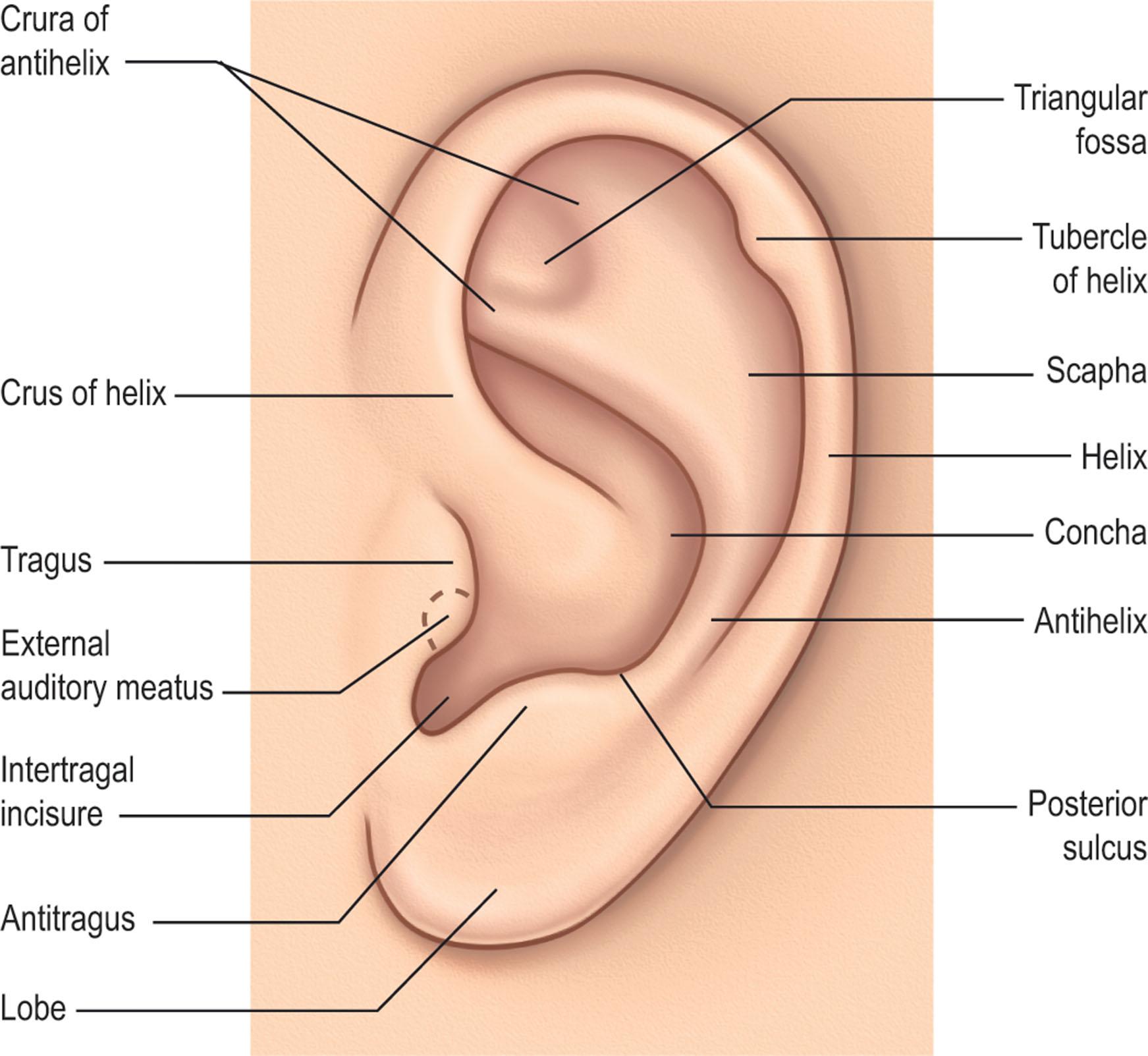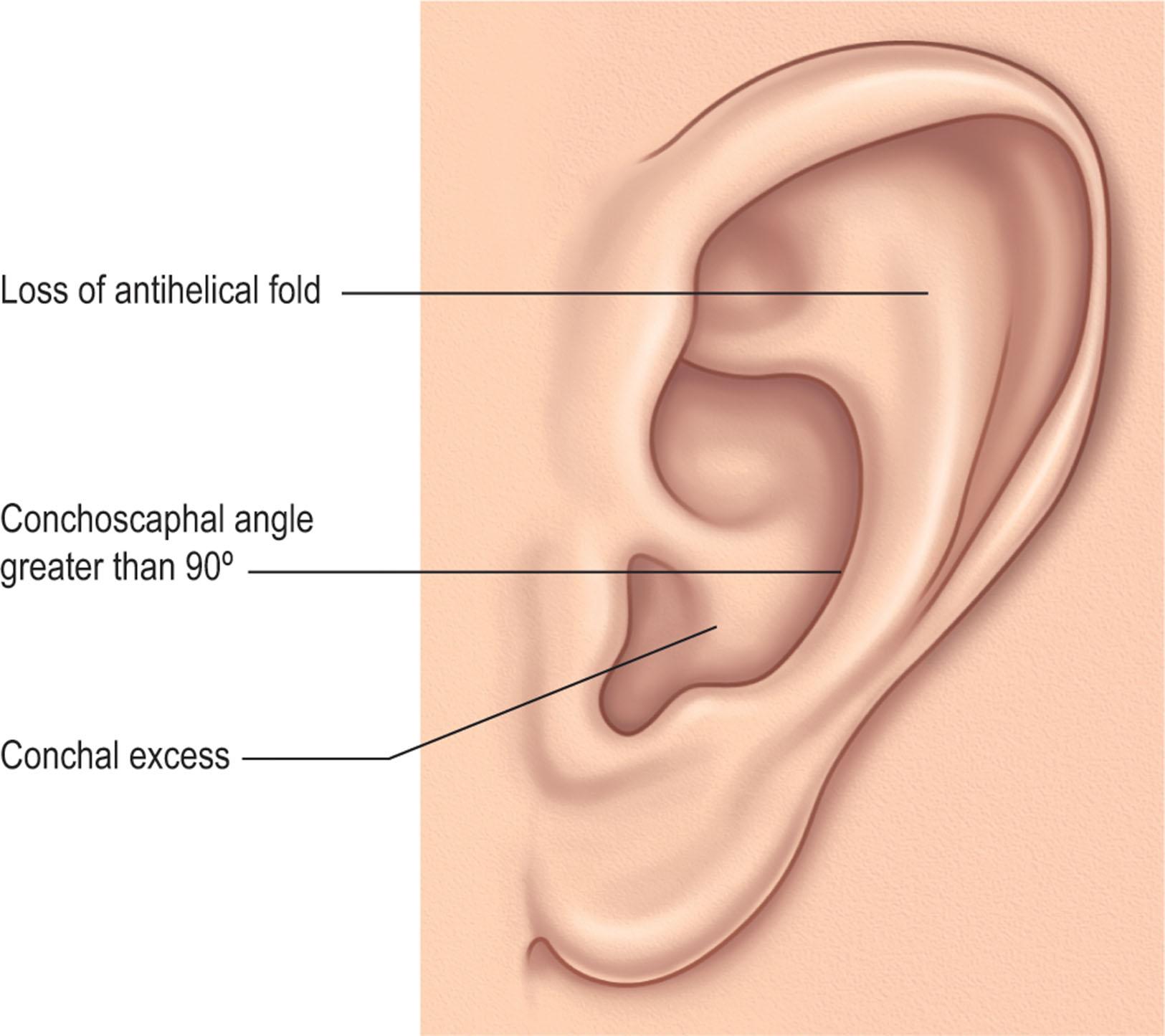Physical Address
304 North Cardinal St.
Dorchester Center, MA 02124
Analysis: analyze the problem in thirds.
Endpoint: know what normal looks like, so you know your surgical endpoint.
Do not be destructive. Do not do anything to the ear that cannot be reversed.
Skin is precious. Preserve skin in the sulcus, and do not rely on skin tension to maintain ear position.
Lobule: consider lobule setback in every case.
Asymmetry: in asymmetric cases, operate on both ears most of the time.
Some ears need to be made smaller.
Facelifts are otoplasties: do not deform the tragus, lobule or sulcus.
Access video and video lecture content for this chapter online at Elsevier eBooks+ ![]()
![]()
The term “otoplasty” refers to surgical changes in the shape or position of the ear. The most common indication is the patient with prominent, but normally shaped, ears. In this situation, otoplasty is an enormously rewarding procedure for the surgeon and the patient/family, because good results and satisfied patients can be expected in almost all cases. In addition, the technical maneuvers required are among the simplest in all of plastic surgery.
The complexity of the otoplasty procedure increases as the deformity of the ear increases. If correction of prominent ears is at one end of the otoplasty spectrum, then reconstruction of congenital microtia with rib cartilage grafts is at the other. Surgical reshaping of the ears, or otoplasty, is best conceptualized with the whole spectrum of ear deformities in mind; that way, the surgeon will avoid the pitfall of learning a single recipe and attempting to apply it in every situation.
The single most important exercise for the surgeon, before performing any procedure in the otoplasty spectrum, is to have the characteristics of a normal ear firmly in their mind's eye. With proper choice of technique, the surgeon can usually avoid the uncorrectable problems of overcorrection and unnatural contours.
The cause of ear deformities is not known. Some articles in the literature suggest that ear deformities are the result of absent or misplaced muscles around the ear. Some newborn children have extremely soft, pliable ears. When these children have prominent ears and they lie on their sides, the ears tend to fold forward against the cheek, rather than back against the head, tending to make them more prominent as the years go on.
The overall size and shape of the ear is evaluated to determine if the ear is prominent with an otherwise normal size and configuration, or if there are abnormalities in addition to the prominence. Excessively large ears, Stahl's ears, cryptotia, underdeveloped shell-like helical rims, postoperative deformities, cauliflower ears, elongated lobules, or earring-related or facelift-related deformities are noted.
The history of otoplasty techniques is instructive but misleading. Understandably, the original techniques focused on changing the shape of the auricle, rather than on the nuances of aesthetics, the stage we are at today. In the author's opinion, most classical otoplasty techniques, although essential in the evolution of the craft, are unnecessarily destructive to the ear, overly complicated in design, and excessively prone to overcorrection, complications, and unnatural appearance results.
Luckett recommended full-thickness incision through the cartilage along the desired location of the antihelical fold. Converse and others described the combination of full-thickness incisions parallel to the desired antihelical fold, with “tubing” sutures to create the fold. Various authors have recommended weakening of the cartilage along the fold, including Stenstroem, who described anterior cartilage scoring in an effort to generate bending of the cartilage away from the cartilage abrasion. Most of these techniques included, or relied upon, skin excision in the retroauricular sulcus.
The current trend is toward less destructive methods of auricular reshaping, preservation of the retroauricular skin, and concentration on natural, non-surgical-appearing results. The ultimate example of this phenomenon is neonatal, non-surgical molding of the auricle, which can correct many of the deformities for which an otoplasty might later be recommended. Any surgical decision represents a trade-off and this author's approach is no exception. The approach described in this chapter incorporates the bias that undercorrection, recurrence, and suture complications are preferable to overcorrection, unnatural contours, sharp edges, and unrepairable deformities.
The upper third of the ear is evaluated to determine if it is prominent, if the antihelix/superior crus of the triangular fossa is well formed, and if the helical rim is well defined.
The middle third of the ear is evaluated to determine if the concha is overly deep or protruding. In addition, the relationship between the antihelix and the helix is examined to determine if, for example, the underdevelopment of the antihelix/superior crus in the upper third extends into the middle third or if it is confined to the upper third.
The lobule is evaluated to determine if it is prominent. It is important to note that even if the lobule is not particularly prominent on initial examination, it may be excessively prominent once the upper two-thirds of the ear have been corrected.
Asymmetry is noted, mostly because patients and families will always comment on it. In asymmetric cases, it is usually preferable to operate on both ears rather than attempt to set back only the prominent ear to match its less prominent counterpart ( Fig. 23.1 ).

Since otoplasty is perhaps the only cosmetic procedure that can be performed in childhood, additional considerations come into play. The fact that parents and grandparents may be involved in surgical decision-making for a patient who cannot yet express himself or herself alters the doctor–patient relationship.
The degree of prominence/deformity and the age at presentation will determine when a surgical recommendation is made. For young children with very prominent ears and whose parents desire early correction, otoplasty is recommended as early as age 4 years. While there may be situations when earlier intervention is warranted, it is reasonable to view the age of 4 years as a minimum for most otoplasty procedures and its variations. In situations where the entire ear requires reconstruction, as in microtia, this author prefers to follow the recommendations of Firmin and wait until approximately the age of 10 years.
In other cases, the parents may want the child to participate in the decision process and that will necessitate later intervention. General anesthesia or deep sedation by an anesthesiologist is usually required up until the early teenage years, especially in boys. Occasionally, there are girls who are mature enough to request and tolerate the procedure under local anesthesia without an anesthesiologist, but this is rare. It is also common to have patients present at approximately 18 years of age, when they are legally independent, or later when they have earned the money for the procedure. Finally, it is not unusual for adults at almost any age to request correction, either because they have wanted it all their lives or because their desire to have a facelift, for example, has led to the realization that their ears are also prominent.
Families frequently ask about the effect of early surgical treatment on growth of the ears. For whatever reason, this has never been an issue in this author's experience. For one thing, there is a large variation in acceptable ear size. It has also never been shown that an otoplasty retards auricular growth. Finally, many prominent ears are on the large side, and some growth retardation would be welcomed by the patient and/or the family ( Fig. 23.2 ).

While the delicate, complex contours of the ear may be difficult to create de novo (i.e., microtia), anatomic considerations are minimal in standard otoplasty. There is abundant blood supply, making almost any combination of incisions acceptable without the risk of necrosis. There are no motor nerves in the neighborhood. The terminal branches of the great auricular nerve will always be injured, but normal sensory function returns.
The one anatomic structure that can be compromised in otoplasty is the external auditory meatus (conchal setback narrows the meatus). Otherwise, the anatomic considerations of otoplasty are those of preservation: preservation of the sulcus, preservation of the natural softness of the auricular contours, and preservation of the normal landmarks such as the posterior wall of the concha (that is, the middle third of the antihelix).
Become a Clinical Tree membership for Full access and enjoy Unlimited articles
If you are a member. Log in here